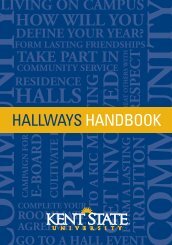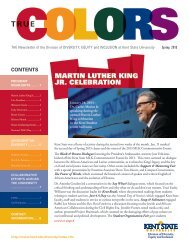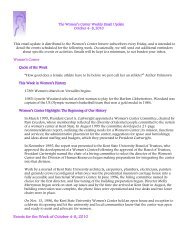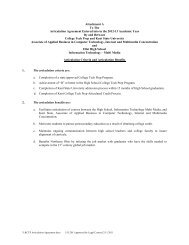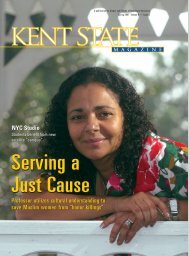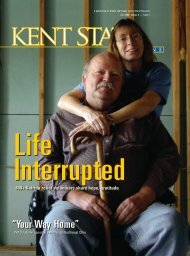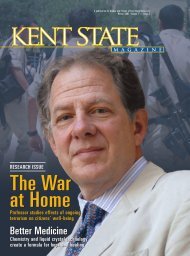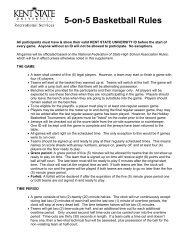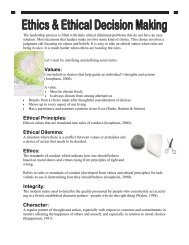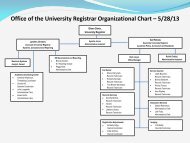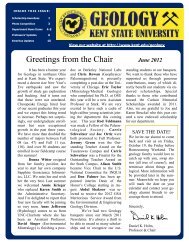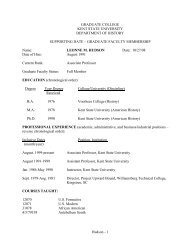E is for Education/Elephant - Kent State University
E is for Education/Elephant - Kent State University
E is for Education/Elephant - Kent State University
You also want an ePaper? Increase the reach of your titles
YUMPU automatically turns print PDFs into web optimized ePapers that Google loves.
O<br />
n Election Day 2006, students asked voters<br />
exiting polls to fill out a survey and respond to<br />
such questions as, “How confident are you that your vote<br />
will be counted accurately?” and “How would you compare<br />
the (new) voting system to the system that had been used<br />
previously at your polling place?”<br />
In some instances, poll workers were concerned about<br />
the exerc<strong>is</strong>e and asked students to leave the prem<strong>is</strong>es, even<br />
though exit polling <strong>is</strong> allowed by state law.<br />
“Which goes to show how much power volunteer poll<br />
workers have,” Claassen says. “More importantly, they can<br />
accept your ID or not accept your ID; they can give you a<br />
ballot or not give you a ballot; and they can allow you to do<br />
a prov<strong>is</strong>ional ballot if an error was made. Poll workers are<br />
surpr<strong>is</strong>ingly powerful in the way an election unfolds.”<br />
The research uncovered that voter confidence in the<br />
two Ohio counties was highly similar, suggesting that even<br />
though different types of voting machinery were used<br />
—touch-screen or optical-scan methods — th<strong>is</strong> difference<br />
was not strongly related to voters’ confidence that their vote<br />
would be counted accurately, says Claassen.<br />
On the other hand, poll workers appear to play a more<br />
central role shaping voters’ confidence than the type of<br />
voting machine used.<br />
Based on earlier studies supporting that notion, the<br />
Claassen survey included a series of questions designed<br />
to study the determinants of the public’s reaction to<br />
poll workers. If poll workers are an important part of<br />
predicting confidence, what factors affect positive versus<br />
negative interactions?<br />
In general, when voters feel good about their<br />
interactions with poll workers, they feel better about their<br />
voting experience and more confident about the electoral<br />
system, the study says.<br />
The group was pleased to find that demographics<br />
weren’t a major factor in the way voters reacted to poll<br />
workers. Although age was a significant predictor, with<br />
older people responding more positively to poll workers<br />
than younger people, race, <strong>for</strong> example, wasn’t significant,<br />
nor was income or education.<br />
“In general, poll workers are treating people in a similar<br />
fashion, which <strong>is</strong> good news,” he says.<br />
On average, poll workers are older people, and th<strong>is</strong><br />
shared demographic could explain the results; or, it <strong>is</strong><br />
possible that poll workers treated older people differently<br />
from young people, Claassen says. Another explanation<br />
could be that older people are likely to have voted many<br />
times. They need the poll worker less because they are<br />
17<br />
familiar with the process, as opposed to a young person who<br />
<strong>is</strong> voting <strong>for</strong> the first time.<br />
Another finding was that the longer a voter waits in line to<br />
cast a ballot, the less happy he or she <strong>is</strong> with the poll worker.<br />
“Th<strong>is</strong> <strong>is</strong> not an entirely surpr<strong>is</strong>ing finding, but <strong>is</strong> one<br />
that has policy implications. There are things that boards of<br />
elections can do to reduce waiting time. These, in turn, can<br />
affect reactions to poll workers, which can cause voters to<br />
feel more or less confident about their votes being counted<br />
accurately,” Claassen says.<br />
In addition to the exit poll research, graduate students<br />
went to polling locations to gather objective measures<br />
of physical conditions. Results revealed that almost none<br />
of the physical conditions of a polling place affected how<br />
voters felt about their experience.<br />
Claassen says th<strong>is</strong> feedback <strong>is</strong> striking because research<br />
shows that when a consumer goes into a store to buy<br />
something, <strong>for</strong> example, every physical aspect of the<br />
location has a bearing on feelings about customer service.<br />
Smell, appearance and the layout of the store impact<br />
customer service ratings, he says.<br />
In terms of voting, the physical aspects of poll locations<br />
had no impact, even though the locations where people<br />
cast their ballots vary widely, from churches to schools and<br />
community centers, or even in garages, he says.<br />
“People are pretty tolerant of physical condition<br />
variations when voting,” Claassen says. “The interaction<br />
<strong>is</strong> different in that if you are going to the store to buy a<br />
lawnmower, you feel like the store owes you an experience.<br />
But if you are going out to do your civic duty, you feel less<br />
like someone owes you. Instead, you are a participant.”<br />
For more in<strong>for</strong>mation, v<strong>is</strong>it www.kent.edu/magazine.<br />
Online exclusives<br />
Alumna Elizabeth (Liza) Bartz-Chames <strong>is</strong> supporting local election<br />
coverage with a $25,000 gift to WKSU-FM.<br />
Alumni are making a difference behind the scenes in key political<br />
positions.<br />
V<strong>is</strong>it www.kent.edu/magazine to read these stories.<br />
K e n t S t a t e U n i v e r s i t y K e n t S t a t e U n i v e r s i t y K e n t S t a t e U n i v e r s i t y K e n t S t a t e U n i v e r s i t y K e n t S t a t e U n i v e r s i t y K e n t S t a t e U n i v e r s i t y K e n t S t a t e U n i v e r s i t y K e n t



